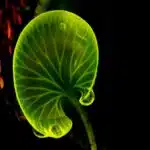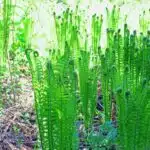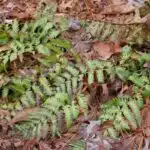Are you looking for a houseplant that adds character to your home while serving as a beautiful backdrop? If so, the Kimberly Queen Fern may be the perfect choice for you! This elegant and easy-to-care-for plant has been popular among indoor gardeners for decades. In this article, we will provide an in-depth look into the Kimberly Queen Fern – from its care requirements to its health benefits – so that you can make an informed decision about adding it to your home.
The Kimberly Queen Fern is known for its lush fronds and impressive growth rate. It is native to Australia and New Zealand, where it grows abundantly in moist, shaded areas of rainforests and woodlands. Its delicate fronds grow up to two feet in length, providing a dramatic backdrop wherever it is placed. As an added bonus, this fern is also known for purifying indoor air by removing toxins from the environment.
Unlike many other houseplants, the Kimberly Queen Fern does not require much maintenance or special care in order to thrive indoors. With proper watering and light levels, it will reward you with lush foliage all year round – making it an ideal addition to any room of the home! Read on to learn more about caring for and growing this attractive fern.
What Is A Kimberly Queen Fern?
The Kimberly Queen Fern is a lush and beautiful plant – a breath of fresh air in any home. It’s an evergreen fern whose fronds can brighten up any space, adding life and vibrancy to the atmosphere. But what exactly is this majestic plant?
A Kimberly Queen Fern is an easy-to-care-for fern that prefers moist environments and partial shade. Its fronds can reach up to two feet long, making it an impressive addition to any garden or home. The fronds are also quite durable, so don’t worry about them being too delicate for your home.
This attractive plant is popular around the world, as it is relatively low maintenance and can survive in both hot and cold climates. It does require some additional care: for example, make sure to keep the soil moist, provide indirect sunlight and occasional misting with water will help keep these plants looking their best. With a little bit of TLC, you can have a magnificent Kimberly Queen Fern in your own home!
With its beautiful fronds and ease of care, the Kimberly Queen Fern makes an excellent addition to any space – whether indoors or out. Now that you know more about this gorgeous fern, you may be wondering where best to place it – stay tuned for our next section on planting tips!
Where To Plant Kimberly Queen Ferns
When it comes to planting Kimberly Queen Ferns, there are a few key considerations to keep in mind. Location and soil quality will play a large role in the success of your fern, so understanding these factors is essential. Let’s take a look at the best places to plant this stunning foliage plant:
• Indoors: If you’re looking for an elegant, low-maintenance way to bring greenery into your home, Kimberly Queen Ferns are perfect! This hardy variety of fern can thrive indoors if given indirect light and humidity. Make sure they are placed away from drafty windows or vents, as sudden changes in temperature could cause stress to the plants.
• Outdoors: For those with more of a green thumb and an outdoor space that’s suitable for planting, Kimberly Queen Ferns can also be planted outdoors. Keep them in partially shaded areas where there is some protection from direct sunlight and wind. When choosing an area for your plants, remember that they require well-drained soil with plenty of organic matter.
Finally, when selecting a location for your ferns make sure that the space is big enough for their full size potential while allowing adequate air circulation around them. With proper care and the right conditions, these gorgeous plants will grow happily in both indoor and outdoor settings. Now let’s move on to discuss watering and humidity requirements for keeping our Kimberly Queen Ferns healthy!
Watering And Humidity Requirements
The lush, glossy leaves of the Kimberly Queen Fern are like a verdant oasis in any garden. Its graceful, cascading fronds create a tranquil atmosphere as they sway ever so slightly in the breeze. But, to ensure this stunning fern is able to thrive, there are certain watering and humidity requirements that must be met.
When it comes to watering, Kimberly Queen Ferns prefer their soil kept consistently moist. Aim for at least 1 inch of water per week. This can be achieved by using a light sprinkler system or by hand-watering with a hose or watering can. To avoid soggy soil and root rot, let the top few inches of soil dry out between waterings.
Maintaining an adequate level of humidity is also important for these ferns. They do best in humid environments—such as bathrooms and kitchens—with temperatures ranging from 60 – 70°F (16 – 21°C). If you don’t have these types of spaces available or if the air is too dry indoors, misting the foliage regularly can help provide additional moisture. Placing your fern on pebble trays filled with water can give them an extra boost as well!
By providing your Kimberly Queen Fern with consistent moisture and adequate humidity levels you will be rewarded with lush growth all year round!
Light Requirements
The light requirements for Kimberly Queen Ferns go beyond the traditional indoor plants. Depending on the location, these ferns can thrive in bright indirect sunlight or even full sun. For those living in colder climates, it’s best to keep them out of direct sunlight as they are delicate and cannot handle extreme temperatures. Here are some tips to help you get the right amount of light for your Kimberly Queen Fern:
• Place your fern near an east or west facing window if possible; this will provide the appropriate amount of sunlight while avoiding hot afternoon rays that could harm your plant.
• If you don’t have a window nearby, consider using artificial lighting such as LED grow lights to mimic natural sunlight.
• Another way to provide adequate lighting is by placing your fern outdoors during warmer months and bringing it inside during colder ones.
• Keep in mind that too much sun can damage your fern’s leaves, so make sure to adjust accordingly if you notice any changes in the leaves’ color or shape.
No matter where you choose to keep your Kimberly Queen Fern, just remember that proper lighting is essential for its health and growth! Providing the right amount of light will ensure that your plant continues to thrive for many years to come. Now that we’ve discussed light requirements, let’s move on to soil and fertilizer needs – two equally important aspects of growing Kimberly Queen Ferns.
Soil And Fertilizer Needs
Caring for your Kimberly Queen Ferns is an important part of keeping them healthy and thriving. To ensure that your ferns get the nourishment they need, it’s essential to pay attention to their soil and fertilizer needs.
Providing a proper environment for the ferns to take root involves creating the ideal mix of soil and nutrients. For best results, create a mixture of equal parts organic compost or peat moss with regular potting soil. This combination will give your ferns the necessary nutrients while providing excellent drainage. Additionally, you should consider adding a slow-release fertilizer in the springtime to keep them growing strong all season long.
To ensure that your Kimberley Queen Ferns are getting just the right amount of nutrition, it’s important to monitor them closely. Make sure you’re checking their soil regularly to make sure it remains moist but not soggy. It’s also a good idea to add some fertilizer every few weeks during the growing season for an extra boost of energy and nutrition. With these tips in mind, you can be sure that your Kimberley Queen Ferns will remain healthy and happy for many years to come!
Pruning And Maintenance
When it comes to pruning and maintenance, Kimberly Queen Ferns are easy to care for. With the right amount of trimming, your fern can stay looking lush and healthy year-round. Pruning can help to keep the plant in shape while removing any dead or damaged fronds. To do this, use sharp scissors or shears to cut off individual fronds at the base of the plant. You should also remove any yellowing leaves as they appear.
Regularly cleaning your Kimberly Queen Fern can also help with growth and health. It’s a good idea to gently remove dust from the leaves using a soft cloth or brush every few weeks. This will allow more light to reach the lower parts of the plant, helping it thrive. Keeping spider mites away is also important – wiping down leaves with a damp cloth will help prevent them from settling in.
With proper pruning and regular maintenance, you’ll find that your Kimberly Queen Fern will stay looking vibrant and healthy for years to come. Next up, let’s take a look at common pests and diseases that can affect this beautiful fern—and how you can protect yours!
Common Pests And Diseases
Fortunately, Kimberly Queen Ferns are fairly resistant to pests and diseases. However, like any plant, it’s important to be aware of the potential issues that may arise. In this section, we’ll cover the most common pests and diseases that can affect these ferns.
The most common pest is aphids, which are small insects that feed on the sap of plants. They can cause leaf curling and yellowing if left untreated. To prevent and manage an aphid infestation, you should use a pesticide or insecticidal soap spray on the affected areas of the plant.
Another issue you might encounter with your Kimberly Queen Fern is fungal disease. Fungal diseases can cause discoloration and wilting of leaves, as well as spots or patches on them. To prevent fungal disease from occurring in your ferns, make sure they’re planted in well-draining soil and avoid overwatering them. If your fern does become infected with fungus, treat it with a fungicide or biological control method such as introducing beneficial insects into the environment around it.
With these tips for preventing pests and diseases in mind, let’s move onto propagation techniques for Kimberly Queen Ferns — so you can grow your own healthy plants!
Propagation Techniques For Kimberly Queen Ferns
Propagating Kimberly Queen Ferns is like growing a lush, green garden in miniature. This delightful fern is a breeze to propagate; allowing you to share the beauty of this unique plant with family and friends. Let’s explore some of the easy and rewarding ways to propagate Kimberly Queen Ferns.
The primary way to propagate these plants is through division. When your fern has become root-bound it’s time to divide the rhizomes and replant them in separate containers. Make sure each piece has at least one frond attached and several healthy roots. Planting them in moist soil ensures they will take off quickly and continue to thrive in their new homes.
Another option for propagating Kimberly Queen Ferns is by taking cuttings from existing plants. Cuttings should be taken from stems that have at least three or four fronds on them, then insert into moist soil or moss for rooting. You can also use a potting mix formulated for ferns for best results. TIP: Keep cuttings out of direct sunlight until there’s evidence of new growth before transplanting into small pots or garden beds outdoors when the weather allows.
Propagating Kimberly Queen Ferns doesn’t have to be difficult or time-consuming; just follow these simple tips and you’ll be enjoying your own little jungle in no time! With these techniques, you’ll be able to share this beautiful plant with others, creating a cascade of lush foliage wherever it goes!
Troubleshooting Tips
Much like any other gardening venture, there can be challenging moments when it comes to caring for and growing Kimberly Queen Ferns. Thankfully, with a few troubleshooting tips, these moments can be met with relative ease.
Picture a lush green garden oasis filled with soft fronds of the Kimberly Queen Fern – an idyllic landscape that anyone would be proud of. Yet, despite our best efforts and intentions to create the perfect environment for these plants to thrive in, sometimes things don’t always go as planned. That’s why it’s essential to understand how to troubleshoot common issues before they arise.
It’s important to recognize early signs of distress or disease; if your Kimberly Queen Fern is looking unhealthy or wilted, check the soil and ensure that it is adequately moistened but not excessively wet. Additionally, you should inspect for pests such as aphids or mites that may have invaded your plant. Lastly, keep an eye out for browning leaves as this could indicate an iron deficiency in the soil; adding compost or fertilizer will help your fern flourish again in no time.
If you take these tips into consideration and apply them accordingly, you’ll be able to ensure optimal health for your Kimberly Queen Ferns regardless of challenges that may come up along the way. Now that we’ve discussed troubleshooting tips, let’s move on to learning how to winterize these beautiful plants.
How To Winterize Kimberly Queen Ferns
Do you ever feel like the winter season just sneaks up on you and catches you unprepared? Well, it’s no different when it comes to winterizing your Kimberly Queen Ferns! You could be happily tending to your ferns one day, only to have them freeze overnight. But don’t worry – with a few simple steps, you can ensure your ferns make it through the cold weather unscathed.
First off, if temperatures drop below 40°F (5°C), then it’s time to start thinking about winterizing. Move your potted ferns into a sheltered area such as an unheated garage or porch. If possible, try to find a spot that gets some bright light throughout the day. This will help keep your plants from getting too cold and going dormant for the season.
Once you’ve moved your plants indoors, be sure to check them every few days for signs of stress or damage from the cold. Make sure they are still well-watered and misted regularly if necessary. If temperatures outside dip below freezing, bring them inside and keep them there until warmer weather arrives. While you don’t want to leave them in too warm of an environment all winter long either, this will help protect them during any sudden cold spells that may come along.
With just a little preparation beforehand and regular monitoring throughout the season, you can help ensure that your Kimberly Queen Ferns stay healthy and happy all winter long!
Benefits Of Growing Kimberly Queen Ferns
Evergreen elegance, anyone? Enter the Kimberly Queen fern! These hardy houseplants are a real show-stopper, making them a popular choice for home decorators and green thumbs alike. With just a few simple steps for care and maintenance, you can enjoy lush leaves year round. Let’s dive in to the amazing benefits of growing Kimberly Queen ferns!
First off, these ferns prefer bright indirect light but can tolerate low light conditions if needed. So don’t worry if you don’t have that perfect sunny spot – they’ll still thrive! And their toughness doesn’t stop there. They won’t need much water or fertilizer either; just a little bit every so often will keep them healthy and happy.
The next great benefit is the luscious texture and color of Kimberly Queen fern leaves. The fronds come in a range of shades from deep green to lighter yellowish-green hues, adding an eye-catching contrast to any room. Plus, the leaves stay soft and fluffy even when dry – no crunchy brown fronds here!
TIP: If space is limited in your home or office, hang up your Kimberly Queen Fern in a basket or pot with plenty of drainage holes to allow air circulation. This will help keep your plant healthy while giving it an eye-catching look at the same time!
Creative Uses For Kimberly Queen Ferns
As the sun rises, so does the beauty of the Kimberly Queen Fern. From their cascading fronds to their deep green hue, these plants have an undeniable aesthetic appeal. And if you’re looking for more than just a pretty face, you won’t be disappointed—these ferns also offer a number of creative uses.
Not only are Kimberly Queen Ferns beautiful, but they can also serve as an excellent natural air purifier. These ferns naturally absorb formaldehyde from the air, making them ideal for any home or office that needs a bit of freshening up. Plus, their large size means they make a great statement piece in any room!
But that’s not all—Kimberly Queen Ferns can also be used in crafts and DIY projects. You can use the leaves to make unique cards or wall decorations; add some life to your next event with a few potted Kimberly Queen Ferns; or even create an outdoor living space with one or two strategically placed plants. With such versatility, it’s no wonder why these ferns are so popular!
The possibilities are truly endless when it comes to using Kimberly Queen Ferns in creative ways—all while enjoying their beauty and air-purifying capabilities. So if you’re looking for something special to spruce up your home or workspace, this might just be the perfect solution! Moving on from here, let’s explore some landscaping ideas for Kimberly Queen Ferns.
Landscaping Ideas For Kimberly Queen Ferns
Surprisingly, Kimberly Queen Ferns are a popular choice for landscaping projects. In fact, they’re one of the most sought-after plants when it comes to creating an attractive and lush look in any outdoor space. But what makes them so desirable? Let’s explore some of the landscaping ideas you can use with these ferns to create an inviting space.
When it comes to landscaping with Kimberly Queen Ferns, there are a few different approaches. For starters, you can use them as borders along pathways or around garden beds. Not only will this help contain soil and add a touch of greenery to your yard, but it will also provide a neat and tidy look. Furthermore, these ferns can be used as ground cover beneath trees or around other plantings for more texture and contrast.
You can also consider adding containers of Kimberly Queen Ferns around your outdoor living space. These containers make great accents that draw attention from visitors and passersby alike. Plus, if you place them strategically throughout the yard, they can create focal points that help tie together different areas of your yard. Finally, these plants make great additions to hanging baskets too – they love humid environments!
By utilizing all these creative approaches to landscape with Kimberly Queen Ferns, you’ll be able to transform any outdoor area into an inviting oasis full of beauty and nature. So don’t forget about this versatile plant when considering ways to add life to your home’s exterior! Now let’s explore some interesting facts about Kimberly Queen Ferns that might surprise you…
Interesting Facts About Kimberly Queen Ferns
As they gracefully sway in the breeze, Kimberly Queen ferns are a remarkable sight to behold. But what is the story behind these majestic plants? From their unusual beginnings to their unique characteristics, there are some interesting facts about Kimberly Queen ferns that you may not know.
To start, it’s believed that Kimberly Queen ferns were accidentally created by a nursery worker in Florida in 1904 who was trying to create a hybrid of two other types of ferns. Since then, they have been cultivated and grown with great success all around the world. Not only are they resilient and easy to grow, but also they possess an impressive ability to tolerate both dry and humid climates.
What else makes Kimberly Queen ferns so special? The fronds of this species can reach up to three feet long, making them larger than most other types of ferns. The leaves have a glossy texture with scalloped edges and an eye-catching emerald green color. And if you’re looking for something even more unique, you’ll be glad to know that this type of fern produces multiple crowns per plant!
Kimberly Queen Ferns have certainly earned their place as one of the most popular ornamental plants today — taking into account all of their interesting qualities, it’s no surprise why! Now let’s explore how we can make sure these lush beauties thrive in our gardens.
Tips For Successfully Growing Kimberly Queen Ferns
Growing Kimberly Queen Ferns is an enjoyable and rewarding experience. They are easy to care for and can bring a unique element of beauty to any space. With the right tips, you can ensure success with these beautiful plants.
When it comes to caring for Kimberly Queen Ferns, the key is to provide them with plenty of humidity. Place your fern in a spot that gets bright light but isn’t exposed to direct sunlight. This will help keep them from drying out and also prevent discoloration from too much sun exposure. It’s also important to maintain consistent moisture levels in the soil; moisten it when it starts to feel dry, but don’t let it become soggy or overly wet. Feed your fern with a balanced fertilizer once per month during the growing season for best results.
If you’re looking for an added challenge, consider repotting your fern every few years into a larger pot with fresh soil. Be sure your pot has adequate drainage holes so excess water can escape; this will help avoid root rot and other problems associated with too much moisture in the soil. With regular pruning and trimming, your Kimberly Queen Fern will look its best throughout the year!
Frequently Asked Questions
How Often Should I Water My Kimberly Queen Fern?
Surprisingly, Kimberly Queen Ferns are considered drought-resistant and only require watering once a week. An interesting statistic is that these ferns can survive for up to four weeks without water! However, the amount of water needed will depend on several factors such as the size of the pot or soil type.
To ensure that your plant is healthy, it’s important to adjust the watering schedule accordingly. For example, if you live in a hot, dry area with lots of sun, then you may need to water more often. On the other hand, if your plant is in an area with high humidity and shade, then less frequent watering may be necessary. It’s all about finding what works best for your specific environment and conditions.
It’s also important to remember that overwatering can be just as damaging as underwatering a Kimberly Queen Fern. To avoid this issue and ensure optimum growth, use your finger to test the moisture level in the soil before adding any additional water. If you feel moisture beneath the surface – even just a little bit – then it’s best to wait until it dries out completely before adding any more water. This way you can make sure that your fern has just the right amount of hydration for its needs!
What Type Of Fertilizer Should I Use For My Kimberly Queen Fern?
It’s like a game of chess with your Kimberly Queen fern – you have to make sure every move is calculated and precise. When it comes to fertilizing, getting the right type and amount is key for keeping your fern healthy. So, what type of fertilizer should you use?
Fertilizer can be a tricky thing – using the wrong kind, or too much, can damage your plants. For Kimberly Queen ferns, it’s best to use a slow-release granular fertilizer that contains balanced nitrogen and other essential minerals. To be safe, choose an organic fertilizer over chemical options since they are less likely to burn your plants.
When applying the fertilizer, spread it evenly around the base of the plant at about 3/4 cup per square meter. Don’t forget to water the area thoroughly afterwards so that all nutrients are absorbed into the soil. This routine should be done every two months during spring and summer and once in autumn for optimal results.
Now your Kimberly Queen fern has everything it needs to thrive! With a little bit of TLC, you can ensure this beautiful houseplant remains healthy and happy for years to come.
How Much Light Does A Kimberly Queen Fern Need?
When it comes to growing your Kimberly Queen Fern, there are a few important factors that you must consider. One of the main considerations is how much light the fern will need to stay healthy and vibrant. In this article, we’ll explore what kind of lighting requirements this type of fern has and how to provide the best environment for optimal growth.
When it comes to light requirements, Kimberly Queen Ferns do best in bright indirect sunlight or partial shade. They don’t require direct sunlight, but they should be placed in an area where they can get some light during the day. Here are four tips for providing the right amount of light for your Kimberly Queen Fern:
- Place your fern near a south- or west-facing window, so that it gets plenty of daylight without being exposed to too much direct sun.
- Make sure your fern is not too close to a heat source such as a radiator or air vent, as this could cause it to dry out quickly and become damaged.
- If you’re keeping your fern outdoors, make sure you place it in an area with partial shade so that it doesn’t get too much direct sunlight.
- If you find that your fern isn’t getting enough light indoors or outdoors, consider investing in artificial grow lights to give it a boost of energy.
By following these tips, you can ensure that your Kimberly Queen Fern gets just the right amount of light and grows healthy and strong. With proper care and attention, these beautiful ornamental plants can bring life and beauty into any home or garden setting!
How Long Does It Take For A Kimberly Queen Fern To Propagate?
Propagating a Kimberly Queen Fern is like being part of a secret club – it’s something that not many people know how to do. The trick is all in knowing the right steps to take and understanding just how long it will take for the ferns to be ready. Allusion: With the proper care and patience, propagating a Kimberly Queen Fern can be rewarding and enjoyable.
First, let’s look at the light requirements for this fern. It does best when in partial shade with indirect sunlight, so make sure to place it away from direct sunlight. Secondly, it’s important to understand that these ferns naturally propagate by themselves via spores which are found on the underside of mature fronds. As such, most propagation attempts require patience as they can take anywhere from one to two months to begin growing, depending on the conditions they are placed in.
Once your fern has started growing, you’ll want to provide water regularly and keep an eye out for any signs of disease or pest infestations that may occur. Additionally, fertilizer should also be applied during the early stages of growth; however, too much fertilizer can cause damage so be sure to follow directions carefully.
With consistent care and attention, your Kimberly Queen Fern will eventually become healthy and lush – creating an attractive addition to any garden or home decor setting!
How Can I Control Common Pests And Diseases On My Kimberly Queen Fern?
Growing Kimberly Queen Ferns can be a rewarding activity, as these plants are known to be quite resilient and long-lasting. However, it is important to know how to properly care for them in order to protect them from common pests and diseases. According to the American Fern Society, Kimberly Queen ferns have been growing without any major pest or disease issues since their introduction in the 1870s!
When caring for a Kimberly Queen fern, it is important to keep an eye out for any signs of infestation or infection. Common symptoms of pests and diseases include discoloration of leaves, brown spots, wilting stalks and stems, or curled leaves. If you spot any of these signs, it’s best to take action right away by removing the affected foliage and cleaning the pot with soapy water. Additionally, fungicides or insecticides may be applied as necessary.
To help prevent pests and diseases from affecting your Kimberly Queen fern in the first place, try planting it in well-draining soil with plenty of organic matter added for moisture retention. Additionally, avoid overwatering your fern and provide it with adequate air circulation by avoiding placing other plants too close together in the same container. Following these simple steps will help ensure that you have a healthy and happy Kimberly Queen Fern for many years to come!
Conclusion
The Kimberly Queen Fern is a beautiful, low-maintenance type of fern that can bring an abundance of lush greenery to any indoor or outdoor space. With proper care and attention, these resilient plants can thrive and last for many years to come. When cared for correctly, they can even last up to five times longer than other types of ferns!
With the right amount of water, fertilizer, light and pest control, you can be sure to have a thriving Kimberly Queen Fern in your home or garden. Providing them with the optimal conditions they need will ensure they continue to look their best.
It’s no wonder why so many people have chosen this unique variety of fern over other species! As an added bonus, one Kimberly Queen Fern can produce up to 200 fronds per year – that’s enough greenery to cover an entire room!
So if you’re looking for an easy way to bring some life into your home or garden, consider adding a Kimberly Queen Fern. With its attractive foliage and minimal maintenance requirements, it’s sure to make a lasting impression on everyone who sees it.





























